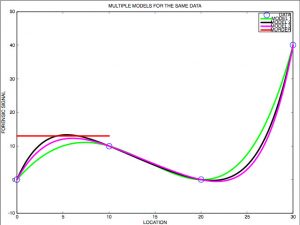
An Unexpected Death
On October 13, 1601 the famous astronomer and astrologer Tycho Brahe (1546-1601) — new friend, confidant, and adviser to the Holy Roman Emperor Rudolf II, one of the most powerful men in Europe — became unexpectedly and gravely ill at a banquet in the Imperial capital of Prague. Tycho was a colorful, athletic and brilliant Danish nobleman who had defied convention by taking a commoner as his wife and by pursuing the study of astronomy instead of the more common pastimes of his fellow nobles in Denmark which he pointedly disdained as frivolous and unimportant.

Tycho suffered horribly for about a week, seemed to begin recovering, and then died unexpectedly on October 24, 1601. Tycho was noted for his good health and vigor. His death came as a surprise to his family, friends, and colleagues.
The Imperial court was a hotbed of intrigue and filled with peculiar and often ambitious men who frequently worked with highly toxic chemicals: astrologers, alchemists and magicians in the employ of the Holy Roman Emperor Rudolf II (1552-1612) who hoped to unlock the secrets of the universe by funding a research program that might be called the Manhattan Project of its time.
From the start there were rumors Tycho had been poisoned and some suspected his assistant the young, equally brilliant mathematician and astronomer Johannes Kepler, remembered today as the author of Kepler’s Three Laws of Planetary Motion.
Tycho was buried with great pomp and circumstance in Prague on November 4, 1601 with some of his friends and colleagues making pointed aspersions in Kepler’s direction during the ceremonies. In time, his beloved wife Kirsten Barbara Jørgensdatter was buried beside him.
Tycho and Kepler
By one year earlier (1600), Tycho had accumulated over a lifetime by far the most accurate measurements of the positions of the planets over time, especially the planet Mars thought by astrologers and kings to influence the occurrence and outcomes of wars and conflict. After years of lavish royal patronage in Denmark, Tycho had a falling out with the new king and fled to the mostly German-speaking Holy Roman Empire of Rudolf II. Here with funding from Rudolf II he hoped to analyze his data and confirm his own novel theory of the solar system, the known universe at the time, in which the Earth was the center with the Sun and Moon orbiting the Earth and all the other planets orbiting the Sun.
Tycho hired the brilliant young up-and-coming astronomer and mathematician Johannes Kepler (1571-1630) to analyze his data. Kepler hoped to use Tycho’s data to confirm his own Theory of Everything based on the hot new Sun-centered theory of Nicolaus Copernicus (1473-1543).

Tycho and Kepler had a stormy working relationship until Tycho’s untimely death in 1601 which left Kepler with the access to Tycho’s data that he desired. In the chaos accompanying Tycho’s death, Kepler quietly walked off with Brahe’s notebooks containing his data on Mars. The ensuing controversy with Brahe’s family was eventually resolved more-or-less amicably, but in the mean time Kepler had the data he had sought.
In one of the great ironies of scientific history, Kepler proceeded to discover that his pet theory, the other variants of Copernicus’s Sun-centered system, the traditional Earth-centered system of Klaudius Ptolemy, and Tycho’s hybrid Earth-Sun centered system were all wrong, although he was never able to fully accept that the data ruled out his system as well.
The models were all mathematically equivalent although they had different physical interpretations. All incorrectly assumed that the motions of Mars and the other planets were built up from uniform circular motion, the infamous epicycles.
Kepler’s analysis of Tycho’s data on the planet Mars took about five years — including his work in 1600 and 1601 when he had limited access to the full data set. In 1605, while taking a break during the Easter Holiday, Kepler had his Eureka moment. He realized that the orbit of Mars was elliptical with the Sun at one focus of the ellipse and that the speed of the planet varied inversely with distance from the Sun so that the plane swept out the same area in the same time. These two insights are now known as Kepler’s First and Second Laws, and they ensured the fame of both Brahe and Kepler to the present day.
Did Kepler Murder Tycho?
In 1991, soon after the end of the Cold War, the National Museum in Prague gave a somewhat peculiar goodwill gift to Denmark, a small box with a six centimeter long sample of Tycho Brahe’s mustache hair, acquired years earlier when Tycho’s crypt was refurbished in 1901. Tycho and his wife’s skeletons were examined and then reburied in 1901, but a few samples were taken and given to the National Museum in Prague.
The gift reopened the old question of whether Kepler or someone else had poisoned Tycho in 1601. Kepler had been a seemingly deeply religious man who had given up a comfortable teaching job in Graz rather than abandon his Lutheran faith and convert to Catholicism. He was later excommunicated from the Lutheran Church for publicly rejecting the Lutheran doctrine of ubiquity with no apparent gain to himself. This latter doctrine was an esoteric theological issue nonetheless of paramount importance in the conflict between the Lutherans, Calvinists, and Catholics that would soon lead to the horrific Thirty Years War (1618-1648).
This same stubbornness in holding to his views and perhaps the jealousy of his colleagues had led Kepler into bitter clashes with Tycho and others during his career. Could such a man have committed murder for the lucrative position of Imperial Mathematician in Rudolf II’s court, fame, or even a fanatical desire to extend human knowledge whatever the cost?
The hair from Tycho’s mustache was examined using modern forensic techniques by Bent Kaempe, Director of the Department of Forensic Chemistry at the Institute of Forensic Medicine at the University of Copenhagen — one of the leading toxicologists in Europe, and potentially lethal levels of mercury detected. Kaempe concluded that:
Tycho Brahe’s uremia can probably be traced to mercury poisoning, most likely due to Brahe’s experiments with his elixir 11-12 days before his death.
Mercury and mercury compounds, some extremely toxic, were widely used in alchemy. Tycho himself used a mercury compound at low doses, potentially deadly at higher doses, for his health — following the alchemical ideas of Paracelsus (1493-1541): the elixir mentioned by Kaempe.
Some experts argued the mercury measurements demonstrated that Tycho had been poisoned and murdered with a mercury compound. Others suggested that the mercury was due to the embalming process or some other contamination of Tycho’s remains.
In 2004, journalists Joshua and Anne-Lee Gilder published a book Heavenly Intrigue: Johannes Kepler, Tycho Brahe, and the Murder Behind One of History’s Greatest Scientific Discoveries popularizing the theory that Kepler poisoned Tycho with mercuric chloride — based on the mercury measurements from Tycho’s mustache hair.
The controversy led to the exhumation of Tycho’s skeleton in 2010 in an attempt to settle the issue. The analysis of Tycho’s remains seemingly ruled out lethal levels of mercury as the cause of death in 2012 and seems to have been generally consistent with natural causes, a bladder infection.
The Limits of Forensic Science
After over four-hundred years, it seems unlikely that we will ever know for sure if Tycho Brahe was poisoned and, if so, by whom. Even today, people in their fifties die unexpectedly from heart attacks and other causes at rates substantially higher than people in their twenties, thirties, and forties. Medicine was very limited in Tycho’s time — often more dangerous than doing nothing in fact. Modern sanitation measures were almost non-existent even at an Imperial court.
On the other hand, Rudolf II had recruited and gathered around himself in Prague some of the most brilliant, highly educated, ambitious, and strange men of his time, many experts like Tycho in toxic chemicals used in alchemy and medicine. Many were probably familiar with plants and herbs available in Renaissance Europe, some of which could have been used as deadly poisons as well. He offered these men enormous wealth at a time when most people in Europe lived in dire poverty.
Kepler’s own mother was accused of and convicted of witchcraft. She was specifically accused of poisoning another woman with a magic potion. Kepler himself was a highly educated and brilliant man. It is quite conceivable that he could have known much about poisons, perhaps even ones unknown or rarely used today. He had close access to Tycho, his boss.
The mercury measurements of Tycho’s mustache hair is one of many examples of overconfidence in forensic science. This overconfidence is often an explicit or implicit claim that forensic techniques — if done right — can give an absolutely certain or almost certain (for example, the one in many trillion odds often quoted for DNA matches in criminal cases) answer.
This false certainty is a claim made by governments, prosecutors, scientists who should know better, and many others. It is heavily promoted in the popular media with television shows like CSI (2000-2015), Numb3rs (2005-2010), Quincy (1976-1983), blockbuster movies like Silence of the Lambs (1991), and many others.
Numerous cases in recent years have demonstrated the uncertainty of forensic methods in the real world. These include the Brandon Mayfield case for fingerprint analysis, the questionable use of DNA “profiling” in the Amanda Knox murder case in Italy, the failure of DNA analysis in the Jaidyn Leskie case in Australia, and many more.
In the case of DNA, the astronomical DNA match odds frequently quoted by prosecutors are highly misleading because they do not include a valid statistical model for the probability of contamination of the samples in the field, at the crime scene by investigators, or at the forensic laboratory where the DNA match is performed. Almost certainly the odds of a false match due to some sort of contamination scenario are much higher than the one in several trillion odds often cited by prosecutors.
Contamination in the field is a likely explanation for the mercury levels in Tycho’s mustache. The mercury may have come from the embalming process. Perhaps Tycho or someone near him somehow spilled some mercury compound on his mustache while he was ill and dying. Tycho worked with and used mercury compounds frequently and they were likely present in his home.
The reality is that there is limited data in many crimes and possible crimes like Tycho’s death. There are usually many interpretations possible for that data, some more likely than others, some improbable but not impossible. In many cases, we don’t even know the prior probability of those interpretations. In the case of Tycho, we don’t know the probability that his mustache was contaminated with mercury by embalming or some other cause.
Mathematically, we now know there are an infinite number of mathematical models that can match any finite set of data with a desired level of accuracy. In an early example of this, Kepler was able to show that the traditional Ptolemaic Earth-centered model of the Solar System, the hot new Copernican Sun-centered model, and the hybrid model of Tycho were mathematically equivalent and matched the data equally well — predicting the future position of Mars in the Zodiac to about one percent accuracy, a few degrees.
Most of this infinity of mathematical models matching a finite data set are extremely complicated. We typically throw out the more complicated models to get a finite set of arguably plausible choices.
Historically, this method of selecting mathematical models has proven remarkably powerful in physics and astronomy. Kepler discovered that a simple mathematical model of non-uniform elliptical motion explained the seemingly extremely complex motions of Mars and the other planets. Newton, Maxwell, Einstein, and others have repeated this success with other data and phenomena including gravitation, electromagnetism, and radioactive decay.

This infinity of possible mathematical models for a finite data set is the mathematical explanation for the many possible interpretations of the data from a crime scene. Even if we exclude extremely complicated and implausible models and interpretations a priori, we are still typically left with a number of possibilities, notably including contamination scenarios with DNA and other forensic methods such as the measurements of the mercury in Tycho’s mustache hair.
The figure above illustrates the many models problem in a forensic context. It shows a simulation with four simulated data points. These data points could be, for example, the strength of a DNA signal or the mercury level in different parts of Tycho’s body. The high point on the right is the mercury level in his mustache hair. The problem is the level could be lower in his body — too low to cause death. The other points could be measurements of the mercury level in various bones from his skeleton.
We don’t actually have the soft tissues where the putative poison would have done its deadly work. These have decayed away. The analyst must therefore infer the mercury level in those tissues over four hundred years ago from measurements today. The red line represents, for example, the threshold for a lethal level of mercury in Tycho’s body. Thus, depending on which model is chosen, mercury did or did not kill Tycho. In reality the forensic analysis is often much more complex and difficult to perform than this simple simulated example and illustration.
In conclusion, the certainty or near certainty often claimed or implied in many forensic analyses is frequently illusory.
(C) 2017 John F. McGowan, Ph.D.
Credits
The image of the planet Mars is from the NASA Jet Propulsion Laboratory (JPL) and is in the public domain. It is a mosaic of images taken by observation satellites in orbit around Mars. It shows the giant Valles Marineris canyon on Mars front and center. It is one of the most popular images of Mars.
The image of Tycho Brahe is from Wikimedia Commons and is in the public domain.
The image of Johannes Kepler is from Wikimedia Commons and is in the public domain.
About the Author
John F. McGowan, Ph.D. solves problems using mathematics and mathematical software, including developing gesture recognition for touch devices, video compression and speech recognition technologies. He has extensive experience developing software in C, C++, MATLAB, Python, Visual Basic and many other programming languages. He has been a Visiting Scholar at HP Labs developing computer vision algorithms and software for mobile devices. He has worked as a contractor at NASA Ames Research Center involved in the research and development of image and video processing algorithms and technology. He has published articles on the origin and evolution of life, the exploration of Mars (anticipating the discovery of methane on Mars), and cheap access to space. He has a Ph.D. in physics from the University of Illinois at Urbana-Champaign and a B.S. in physics from the California Institute of Technology (Caltech).
